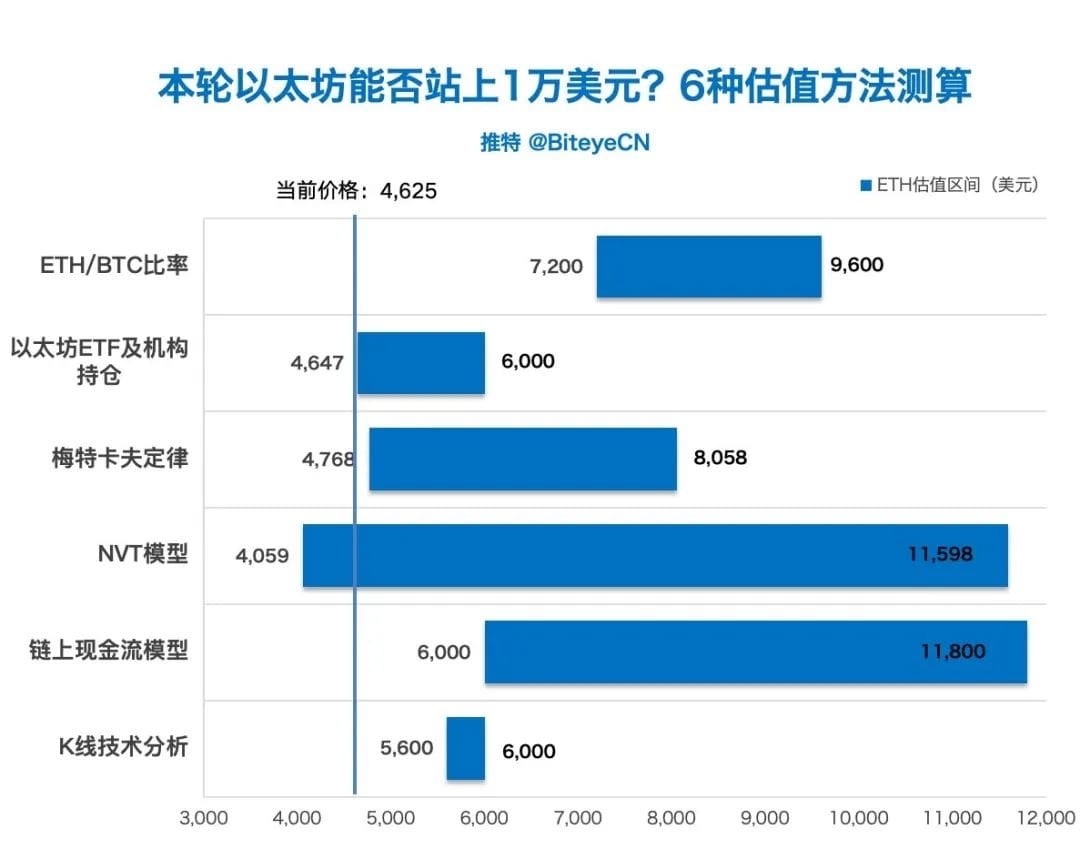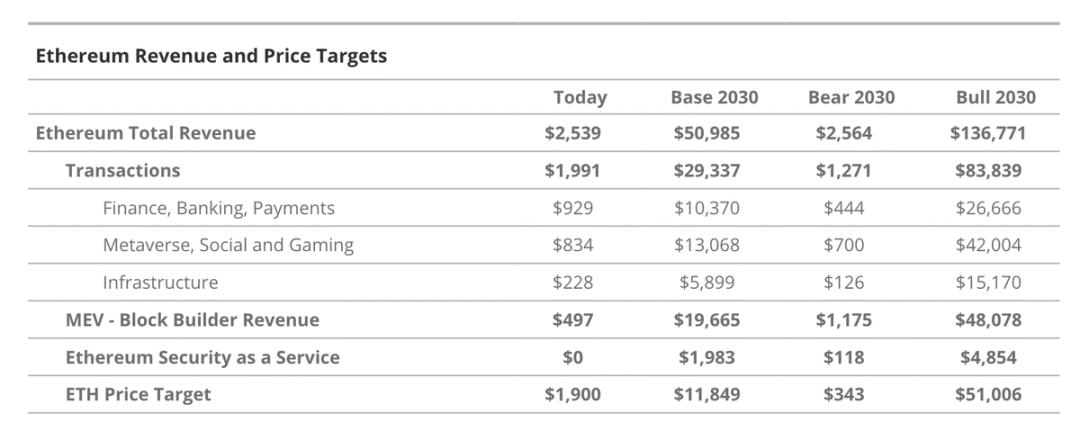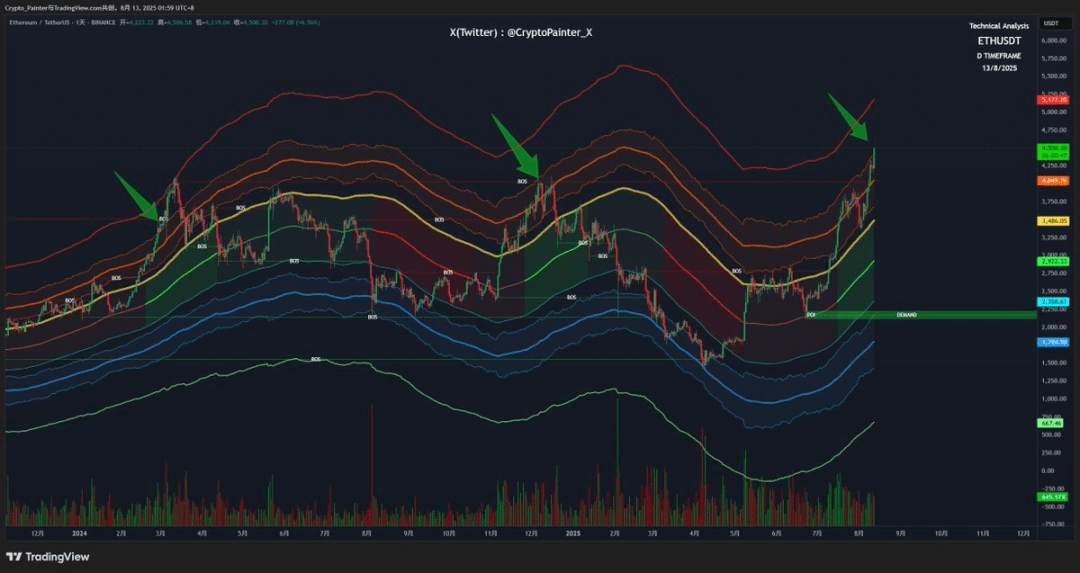Author: Biteye Core Contributor viee
Editor: Biteye Core Contributor Denise
ETH has rebounded all the way from the April low and is currently above the $4500 mark. If 2024 is regarded as the beginning of the bull market ignited by Bitcoin ETF, then in 2025, it is likely to be Ethereum's turn to take the stage. This article uses six valuation methods to analyze whether ETH can hit the $10,000 milestone!

01. ETH/BTC Ratio
First, let's make a relative valuation comparison between ETH and BTC.
The ETH/BTC ratio is actually very stable in the long run, but the current ratio is only 0.0372, which is historically low in the past five years, so there is a possibility that ETH is 'undervalued' right now.
Based on the average ETH/BTC ratio of 0.0518 over the past five years, assuming BTC stays around $120,000, the corresponding ETH price is $6214. If we reference the last bull market's ETH/BTC ratio of 0.06-0.08, still assuming BTC stays around $120,000, the corresponding ETH price would be $7200-$9600.

02. Ethereum ETFs and Institutional Holdings
With the surge in ETH price, off-market funds are pouring into Ethereum ETFs. Many overlook the actual impact of Ethereum ETFs and institutional buying, which is not just a sentiment boost but also a massive buying force.
According to data from @SoSovalueCrypto, Ethereum spot ETFs have reached a historical high, with a net inflow of $1.019 billion on August 11 in Eastern Time, and the current total net asset value of Ethereum spot ETFs is $25.712 billion, with a holding of approximately 6 million ETH, accounting for 4.96% of the current circulating supply of ETH, compared to 6.48% for BTC's ETF, indicating room for growth. Additionally, 70 Ethereum reserve entities hold about 3.49 million ETH, accounting for 2.89% of the circulating supply of ETH. BMNR has publicly set a goal to eventually hold 5% of the global circulating supply of Ethereum. After excluding the staked lock-up of 36.17 million, the free circulating supply is only about 7.51 million.
The following price calculations are based on a simple assumption: the proportion of reduction in free circulating supply will proportionally push up the price of each unit.
That is, New Price = Current Price × (Target Free Circulating Supply / Current Free Circulating Supply)
If we consider the ETF and institutional reserves as a whole, they currently hold 7.85% of the total supply. If this proportion increases to 10% in the future, and the staking lock-up ratio remains relatively stable, the circulating supply will shrink to about 72.52 million, corresponding to a price mechanically moving up to about $4647; if it increases to 15%, it would rise to about $5070; if it increases to 20%, it would be close to $6000.
This does not take into account the demand-side amplification effect; the actual increase may be even higher. Additionally, ETF and institutional incremental funds typically take time to complete delivery, which means that the price center of ETH will be raised steadily and long-term, rather than experiencing a short-term spike.
03. Metcalfe's Law
Many people focus on price fluctuations and hot narratives when discussing ETH valuation but overlook the long-term support that on-chain activity provides for network value. Metcalfe's Law states that the value of a network is proportional to the square of its active user count; applied to Ethereum, this means network value ≈ k × (daily active addresses)².
In simple terms, 'the more users, the more valuable the network,' with a square-level growth in user numbers leading to exponential growth in market value.
According to BitInfoCharts data, on August 13, 2025, the number of daily active addresses (DAA) on the Ethereum mainnet was approximately 971486, with the current price of ETH around $4500, a total circulation of approximately 120.7 million, and a market value of approximately $543.1 billion. Plugging into the formula gives the current coefficient k ≈ 0.576 (USD/address²).
With this k, we can calculate the price under different activity scenarios:
If DAA increases to 1 million, the price will be about $4768 (+6%)
If DAA increases to 1.1 million, the price will be about $5769 (+28.2%)
If optimistic to 1.3 million (close to 90% of historical highs), the price would be approximately $8058 (+79.1%)
This calculation assumes that the staking amount and circulating supply remain relatively stable, and the increase in activity will directly amplify network value, thereby pushing up the price of each ETH. Unlike ETF and institutional buying, the Metcalfe method reflects the endogenous growth of on-chain usage and economic activity; it does not depend on external capital inflows but is based on the compounding accumulation of network effects.
Note that once the activity and liquidity resonate — with increased on-chain transactions, rising fees, and a recovery in burn rates, compounded by the ETF and institutional chip contraction effect, the price of ETH will be driven by both supply contraction and network expansion, and the acceleration may far exceed predictions based on a single factor.
04. NVT Model
NVT essentially acts like a 'crypto version of PE'; given a reasonable NVT multiple (referencing historical ranges) and future daily transaction amounts, the market cap and price can be inferred.
NVT = Market Cap (USD) / Daily On-Chain Transaction Amount (USD), calculating gives current NVT=518B/14B=37
Historically, ETH's NVT has been around the range of 60–110, and it is currently at a historically low position. Assuming the NVT multiple remains in a reasonable range of 60/80/90/100/110 within the next 6–12 months; the on-chain transaction amount (USD) is expected to fluctuate in the future between $7B–$14B per day.
6 Month Scenario
Conservative: NVT 70, daily transactions $7B → Market Cap ≈ $490B → Price ≈ $4,059
Baseline: NVT 80, daily transactions $9B → Market Cap ≈ $720B → Price ≈ $5,965
Optimistic: NVT 90, daily transactions $12B → Market Cap ≈ $1080B → Price ≈ $8,947
12 Month Scenario
Conservative: NVT 75, daily transactions $8B → Market Cap ≈ $600T → Price ≈ $4,971
Baseline: NVT 90, daily transactions $10B → Market Cap ≈ $900T → Price ≈ $7,456
Optimistic: NVT 100, daily transactions $14B → Market Cap ≈ $1400T → Price ≈ $11,598
In other words, the network effect of ETH is supporting a valuation base of $5000-$12000.
05. On-Chain Cash Flow Model
Viewing the on-chain 'revenue' generated by the Ethereum protocol (transaction fees + MEV, etc.) as cash flow, to measure network value. As the Ethereum application ecosystem expands, network 'revenue' growth can enhance ETH valuation.
Asset management company VanEck predicts that in 2025, with the introduction of positive factors like ETF staking rewards for Ethereum, the price of ETH is expected to approach $6000. As early as in their 2023 report, VanEck made a valuation for the price of ETH, assuming that on-chain fees and usage continue to rise, modeling suggests that ETH could rise to about $11800 by 2030. See the chart below:

06. K-Line Technical Analysis
@CryptoPainter believes that although ETH currently faces some historical selling pressure from the supply zone of the 2021 highs, the technical structure on the 4-hour level shows that highs and lows are still slowly rising, with no obvious damage.
From the ASR channel observation, ETH's price is oscillating upwards above the orange average pressure band, which is a strong pattern, indicating that market demand is gradually digesting the supply near historical highs.
The daily ASR channel shows signs of breaking through the average pressure band. The last similar breakthrough occurred at the beginning of 2024, and if this breakthrough is successful, the daily target may directly touch the daily overbought line (around $5600).
Another possibility is to replicate the trend at the end of 2024, facing extreme resistance at the upper edge of the orange channel.
Overall, the current situation remains positive, and there is a possibility for the ETH price to challenge $6000 in the medium term.

07. Cryptocurrency Analyst Scenario Simulation
Some crypto analysts and media have provided a series of scenario-based predictions for the ETH price:
1. Cryptocurrency analyst @VirtualBacon0x believes that ETH has entered a new macro bull market. In the baseline scenario, ETH is expected to reach the $6000-$7000 range by the end of 2025, with a long-term target of about $10000 by mid-2026. If extremely optimistic, with the market being fully euphoric, BTC hitting $200,000 and ETH outperforming, Virtual Bacon estimates ETH could reach as high as $16000.
2. Wall Street analyst Tom Lee bluntly stated in a Bankless podcast in July that in the short term, ETH should at least rebound to $4000; and by the end of 2025, it is reasonable for ETH to rise to $7000, or even reach $12000 or $15000.
3. Former BitMEX CEO Arthur Hayes gives an optimistic target price of about $10000 for ETH by the end of 2025. In an article from July 2025, he emphasized that a shift in U.S. policy towards credit expansion would bring a large amount of liquidity, coupled with renewed interest in Ethereum from Western institutions, these macro factors will be key catalysts for ETH's rise.
4. The cryptocurrency media Bankless proposed in their 2025 outlook that ETH is expected to challenge $15000 in a very bullish scenario. They stated in their annual forecast that new driving forces like the AI boom might trigger a new round of enthusiasm in the cryptocurrency market, and under this optimistic scenario, the price of Ethereum has a chance to climb to the ten-thousand level. The underlying assumptions include ample market liquidity, narrative trends (like AI + Crypto), and the continued consolidation of Ethereum's dominant position in the DeFi space.
08. Summary
Comprehensively using six valuation methods, ETH has a high likelihood of reaching the $6000-$8000 range in 2025. If market sentiment is high and on-chain activity continues to grow, breaking through $10,000 is not impossible, and in extremely optimistic scenarios, it may touch the range of $12000-$15000.
This is not just 'market speculation,' but a joint interpretation of on-chain data, capital behavior, and macro liquidity. Whether or not it really reaches $10,000, ETH, as the infrastructure of the crypto ecosystem, has already established a foothold in multiple value pricing systems.
What does everyone think about the potential of ETH in this cycle? Feel free to comment and discuss.
Risk Warning: The content of this article is for informational reference only and does not constitute any investment advice. The price of ETH is affected by multiple factors including market sentiment, on-chain activity, policy changes, etc., and is highly volatile. Please make decisions based on your own risk tolerance and bear the investment risks yourself.



